Beijing to Ulaanbaatar
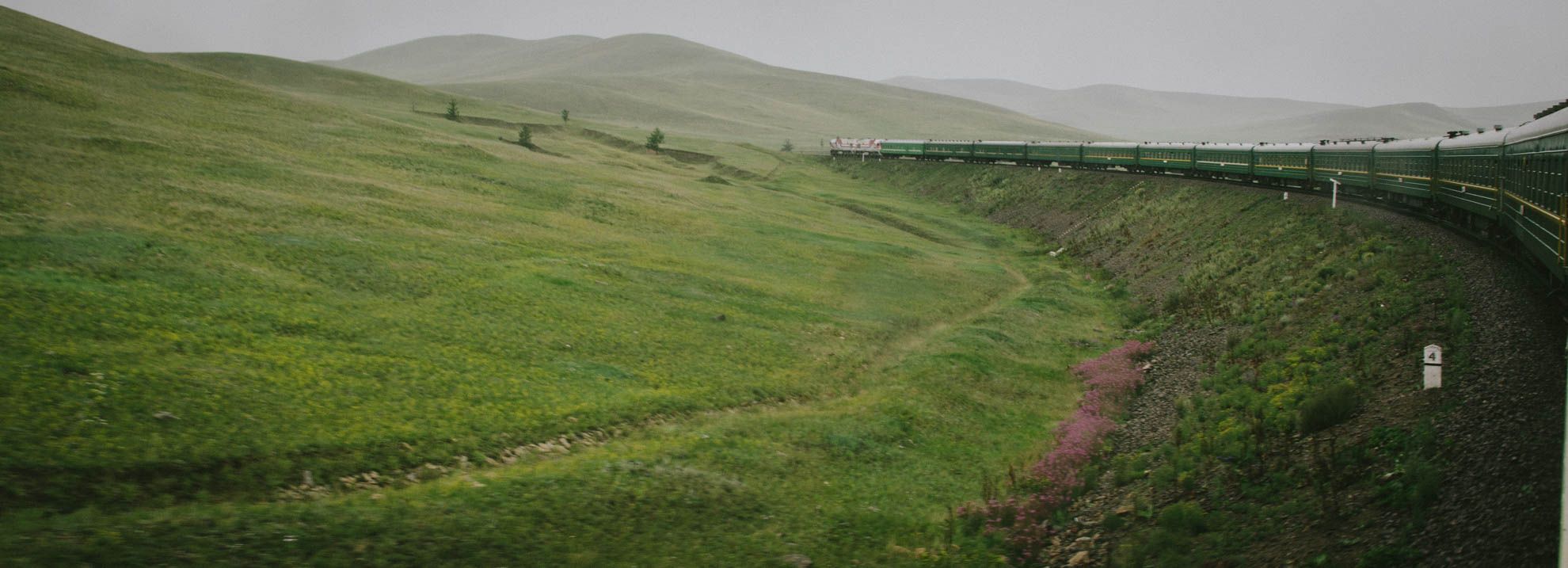
The smell of dry sand tickles my nostrils as the desert rolls by in the dark. Not much can be seen outside except for a strip of sand a dozen meters wide, lit by the light from the trains carriages. When the wind picks up, a cloud of dust is blown through the carriage's open windows and the train attendants scramble to close them.
Welcome aboard overnight express train number 43 from Zamiin-Uud to the capital of Mongolia, Ulaanbaatar. Today is Sunday and according to the schedule this train does not exist as it only runs on Thursdays. I dont mind because after a day in the tiny, desolate border town of Zamiin-Uud I am glad to move on.
How did I go from China to Mongolia? And how did I end up on this train? Let me rewind this story to explain.
This journey actually started two nights ago, in Beijing. With an annoying cough, a left-over from a cold that had bothered me the past days, I travelled to Beijing West railway station. This station is huge — it is the largest railway station in Asia — but I didnt have any trouble locating the waiting room for my train. Two days before, when I picked up my train ticket at this same station I already spent some time to get familiar with the stations layout.
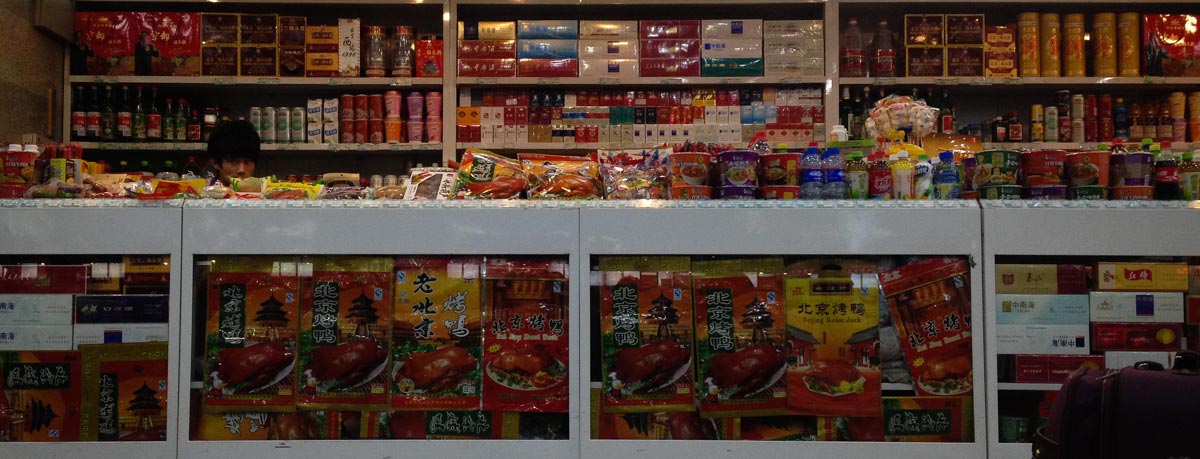
My train with destination Hohhot, the capital of the Chinese province Inner Mongolia, is scheduled to depart just after midnight. This leaves me with a couple hours to kill which I spend reading my book and watching other travellers and their luggage. When it is time to board the train most shops at the station are closing and the herd of people slowly shuffles through the gate that connects with the platform where the train awaits us. I quickly make my way to the carriage and berth assigned to me so I can finally get some sleep. After a few weeks in China I still feel very lost when communicating with people, but at least I start to understand the limited subset of train travel customs. When the carriages attendant shouts something in Chinese I have no idea what she is saying but I hand over my ticket. Fortunately this action satisfies her so it must have been the appropriate response.
I climb in my upper berth where there is just enough space between the bed and the ceiling for me to do uncomfortable sit-ups, if I wanted to. The provided sheets are fresh and clean but the blanket is still damp, which annoys me but I am to tired to ask for another one so I settle in and fall asleep while we leave Beijing behind us.
Reaching the Border
The following morning I wake up well-rested after a good nights sleep. I decide to change my original plan and get off at Jining Nan instead of Hohhot to try to catch another train today to Erlian, at the Chinese-Mongolian border.
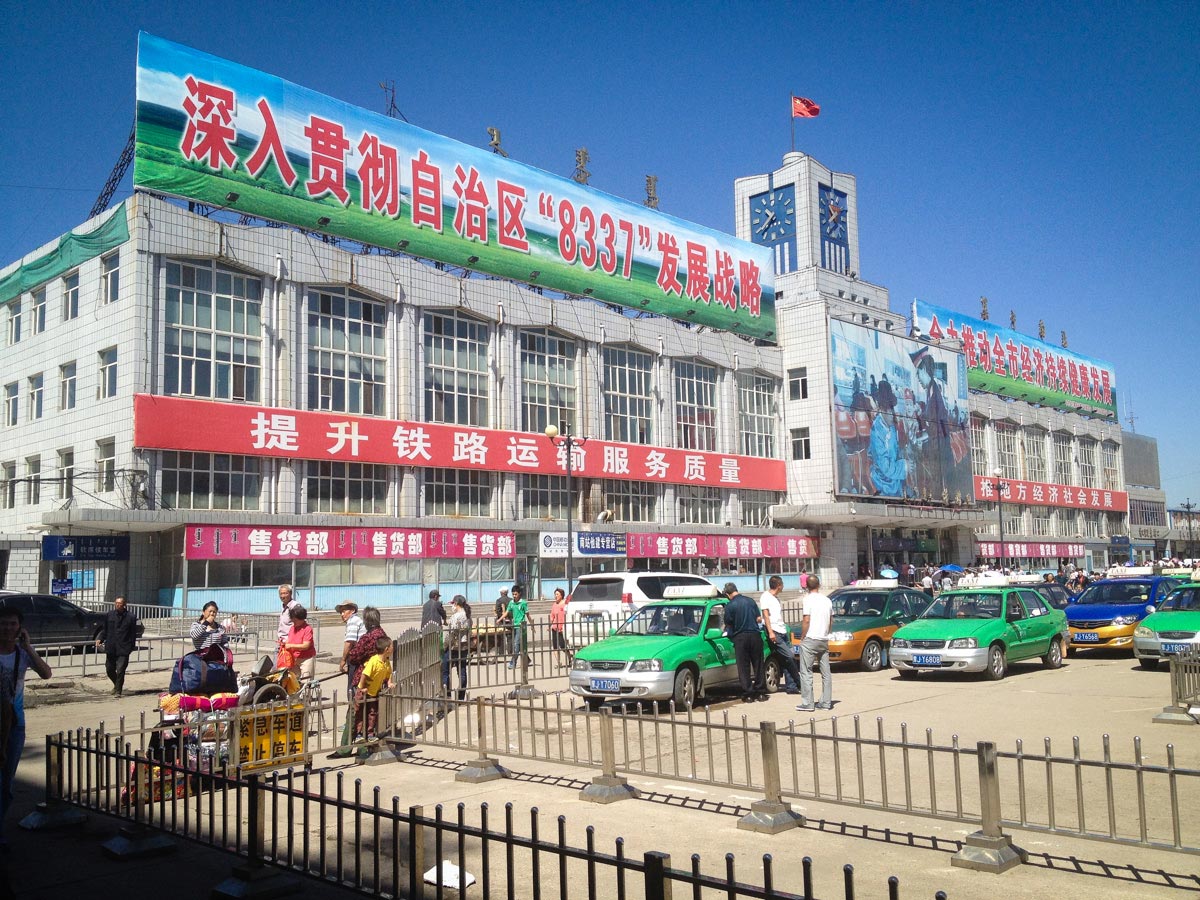
In the line to buy a ticket for train 8657 to Erlian I meet another Dutchman, Remco, who is making the same journey and we decide to join forces and fight off the queue-jumping Chinese together. Half an hour later we leave the station with a new train ticket in our hand. Cost of this seven hour trip from Jining to Erlian? Only 20.50 yuan, or 2,50 euro. One of the reasons for this cheap price is because in Jining Nan only standing-room tickets can be purchased for this train, meaning there are no reserved seats and you have to compete with hundreds of other passengers for the available seats; if you are unlucky you will be standing the entire trip. Also, this train is not as modern as most Chinese trains which means no air-conditioning and harder benches than normal but on the plus side the windows open to let fresh air in.
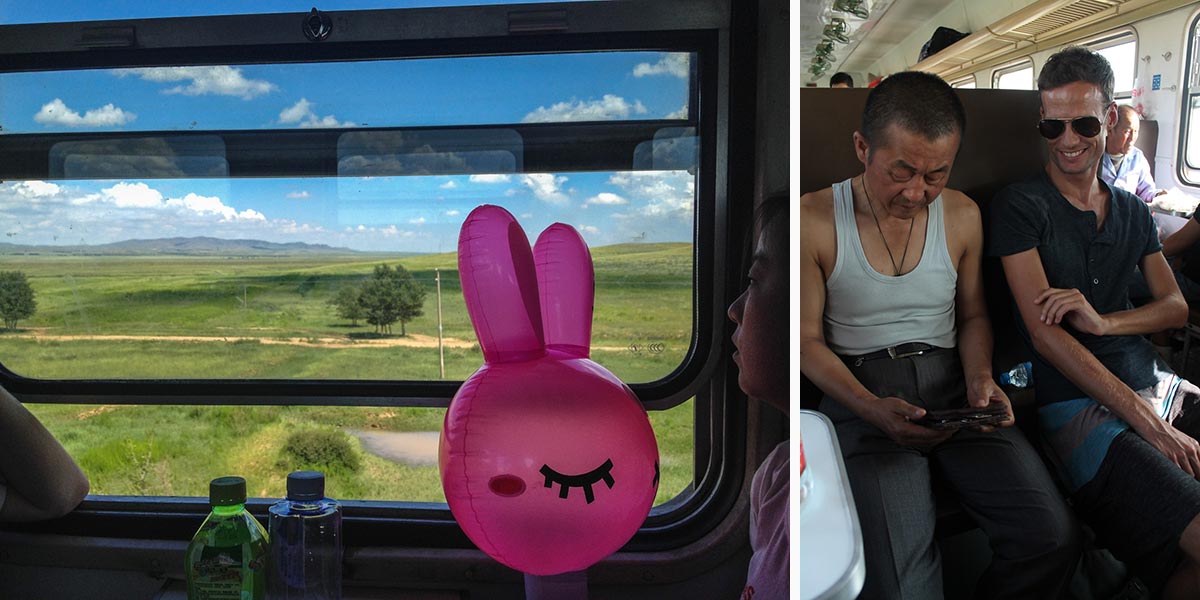
As the train does not leave for another three hours and we havent had breakfast yet we decide to go outside the station and have a look at Jining where I fill my stomach with dumplings and buy additional provisions for the train ride ahead: water, instant noodles and dried-fruits. Even now there is still some time to kill so we settle ourselves in the station's waiting room where we are surrounded by people staring at us for minutes at a time while we perform everyday actions like drinking water, checking the time or walking to the toilet. I cannot get used to this staring. Every move I make is followed by many pairs of eyes filled with curiosity and amazement. As I am tired I just continue smiling sheepishly and wait for the train to depart. When the gates to the platform finally open we push ourselves through and quickly make our way to the front of the train where there are fortunately still seats available. All we have to do now is sit and wait for the train to cover the distance between Jining and Erlian.

The world between Jining and Erlian is empty. Almost every fifteen minutes there is a stop but some of these are nothing more than a small station surrounded by grass as far as the eye can see. We pass a few cities, some towns and a whole lot of emptiness. On board the train people entertain themselves with sunflower seeds and playing cards, children hide underneath benches when tickets are checked and the women socialise at louder and louder volumes. An old Chinese men, a perfect look-alike of Gandalf the wizard famous from the Lord of the Rings, takes a seat at the beginning of our carriage. I buy a lunch with rice, vegetables and some undefinable meatballs from a guy with a cart selling food on the train. This meal is much better than the — more expensive — microwaved lunch I had on the high-speed bullet trains. When I am done with my lunch I put it down on the small table and the guy next to me makes some gestures with his hands which I interpret as him asking if I am finished with my meal. When I answer positively he picks up the plastic box and drops it out of the open window, the Chinese way to get rid of garbage. Slowly but steadily we progress towards Erlian, the final stop for this train at the Mongolian border.
The plaza in front of Erlians train station is a sea of green and yellow taxis which quickly fill up with passengers and drive away into the night. With some research beforehand I had already found a couple of cheap hotels within walking distance of the station. The first option has rooms available, hot water and immediately gives a discount so we look no further and are glad to have made it to Erlian in one day.
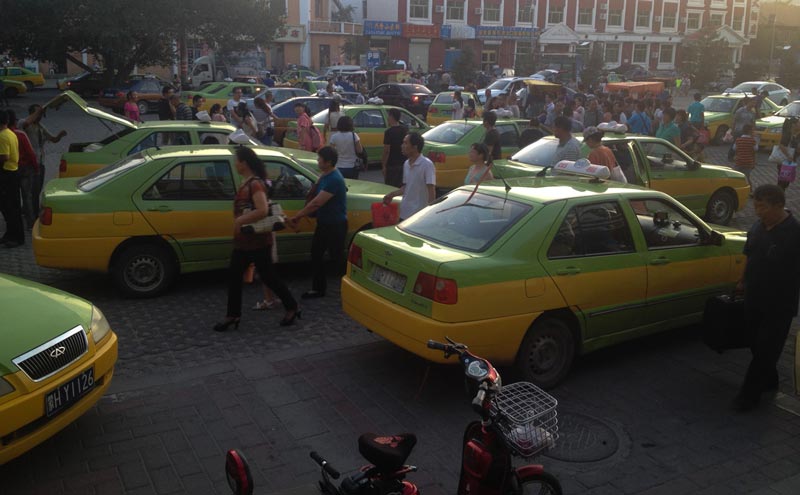
All facilities in this town are geared to people wanting to cross the border; there are numerous hotels, bars and restaurants competing for our attention. We are definitely hungry and have a look at the offerings, food-wise. The local specialty is a complete barbecued chicken but this is a bit to much for our appetite today so we pick a more straightforward meal from the pictures on the wall and enjoy our food with a beer. Many others seem determined to cross the border hungover. After dinner we head back to our hotel for a well-earned shower and some Wifi to check what is going on in the outside world.
Tomorrow will be another day in my journey where I cross the border to Zamiin-Uud in Mongolia, the place where I started this story. From there I'll have to find another train to the capital of Mongolia, Ulaanbaatar. For now I turn off the light and quickly drift away in a deep sleep.
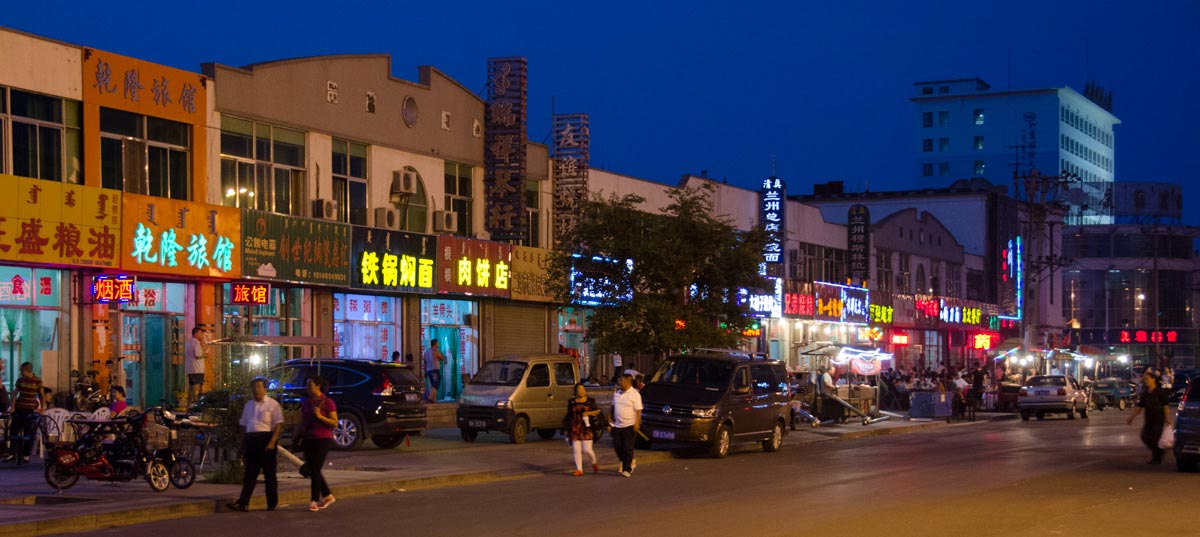
Mongolia!
It is not allowed to cross the border on foot, everyone must enter Mongolia in a vehicle with Mongolian license plates. This law has proven fertile ground for an informal taxi service in Erlian. In the morning old Russian jeeps gather in the town's centre and take goods and people across the border, for a fee. The drivers make this trip several times a day until the border closes in the evening.
We turn up at 8:00 AM and start negotiating with the pack of drivers who initially want 100 yuan (12,50 euro) per person. With a bit of haggling and patience we manage to get this down to 80 yuan per person in a jeep that is already completely filled up with stuff. You could furnish a house with everything in this jeep: a flatscreen TV, a mattress, a microwave and a lot of unidentifiable furniture parts which hopefully come with a description of how to fit it back together. The Mongolians see us thinking _There is no way two people with backpacks are going to fit in here_. But five minutes later a cave has been carved out in all this stuff and we manage to squeeze in. Time to go to Mongolia!
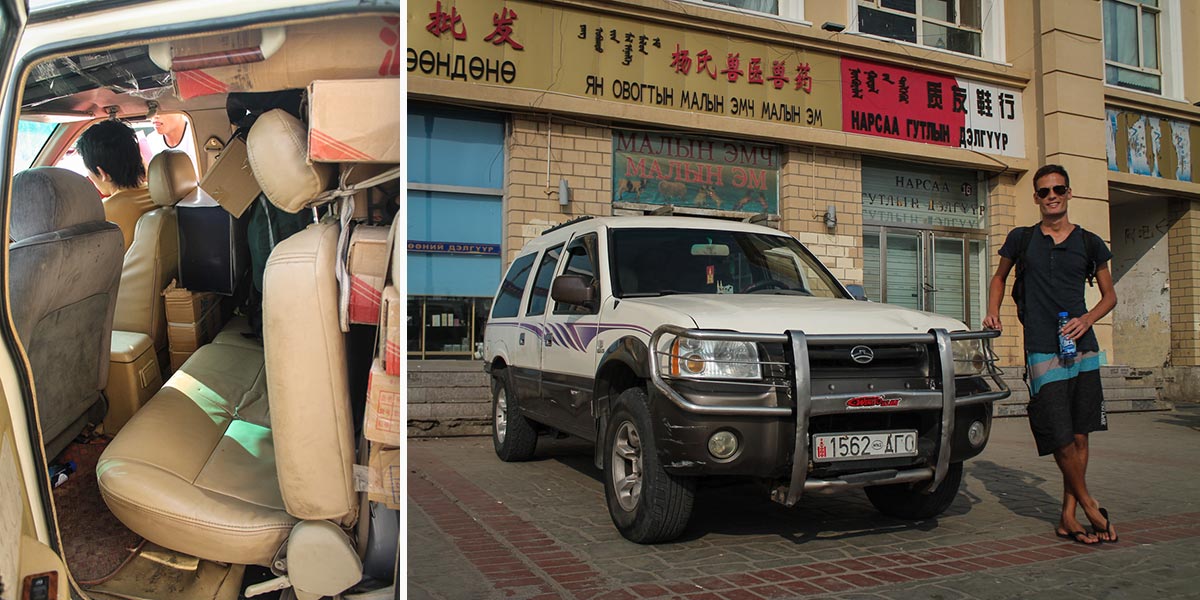
Crossing the border is similar to other border crossings. First, you have to pay money for things that don't make sense, in this case 5 yuan for a small paper that says 5 yuan. No explanation whatsoever, just 5 yuan and you need this ticket or you won't be allowed to leave China. Second, there is the waiting. Waiting in a queue, waiting in a building, waiting outside a building, waiting for customs and waiting for the jeep driver who disappears for an hour. After we finally cross the border with all the required stamps in our passports and all necessary forms filled in a few hours have passed. From where we are now we can still see Erlian only a few hundred metres in the distance but we are now in Zamiin-Uud on the Mongolian side of the border. The difference in wealth is striking, with the Mongolian side being the poorer one. Zamiin-Uud is also tiny compared to Erlian (10.000 people versus 90.000 people).
The next step is to try and obtain tickets for a train to Ulaanbaatar so we locate the ticket office on the second floor of a building next to the old railway station. Only one counter is open and a group of eight Mongolians is already crowded around this counter. At first we queue up behind them as we think they belong together but after a while we realise they are not. They are competing to be the loudest in order to attract the attention of the ticket agent who, no matter what the people do stoically focuses on shuffling the stuff in front of her. We decide to join this comical sight with our backpacks strapped on and surprisingly after a while the Mongolians point at us giving us the ability to inquire about tickets to Ulaanbaatar. According to the timetable posted in the ticket office there is a local overnight train number 275 leaving for Ulaanbaatar at 5:35 PM. It is only 1:00 PM so time is not an issue, the question is whether there are still tickets available for today's train. So far this journey has been pretty smooth sailing but our luck seems to have run out as we understand that there are no more tickets available. My mind is already shifting to hotel-finding mode when one of the Mongolians tells us there is an extra train leaving for Ulaanbaatar today, the express train number 43 leaving at 9:25 PM. Our luck is still alive! We secure two second class sleeping berths and all we have to do now is wait, again.
The Sweet Desert Life
Every new country comes with a new language, different food and another currency conversion rate. Because of this the first hours in a new country tend to be mildly confusing and require more mental and physical energy than normal. Mongolia is no different from any other country I have been to in this respect. _Where is the left luggage office?_ is the first quest we embark on. Luckily Mongolia uses the Cyrillic alphabet which at least has some recognisable characters, as opposed to the Chinese characters that all look like robots and ladders to me. After some asking around we manage to locate the left luggage in the basement of the ticket office, only to find it closed. The sign next to the big yellow door lists the opening hours, according to which the office should be open right now. Apparently time has a different meaning in the middle of a desert.
Walking around in the heat with a large backpack is not really an option so we set up camp in front of the office. Luckily there is an open Wifi connection that I use to book a night in the Sunpath hostel in UB. This hostel provides a free pickup from the train station, something I expect to be very welcome when we arrive in UB the next morning.
I'm hungry. We move ourselves and our luggage to a small restaurant next to the train station and have our first Mongolian meal: mutton with rice and vegetables. Not bad. When I go back to the ticket office to look for a toilet I pass the big yellow doors of the left luggage again, but now they're open! I quickly do my business and return to Remco to tell him the good news. We take our bags and head to the basement, only to find the doors closed again. I seriously start to wonder if I am delirious and may have dreamt that the doors were open but luckily after ten minutes a woman shows up and opens the doors again. By now I am a bit apprehensive to leave my bags here as I fear we might end up in front of closed doors when our train is about to leave. I show the woman my train ticket and point at the departure time, she seems to reassure me that it will be fine. With our big, bulky backpacks out of the way we go outside with our cameras and start roaming the streets of Zamiin-Uud.
I have the impression that here, in the middle of nowhere there is not much work for people. The result of this is a lot of drunk people on the streets, either drinking or fighting. Or both. A nice thing are the billiard tables that are set up outside in the shadow. Great idea. Besides this and a shady karaoke bar there is nothing around. Just sand and emptiness, with China in the distance.
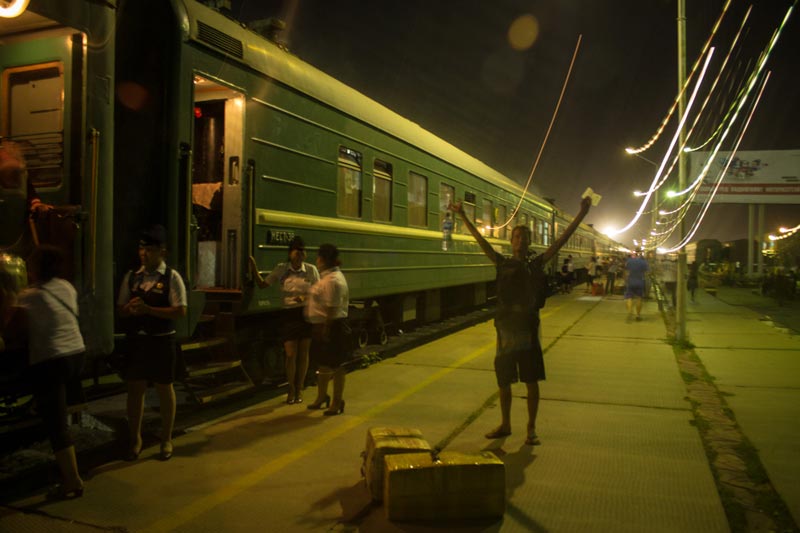
Smooth Green Hills
The sun has set and the train is waiting for us at the station. I make my bed while we roll into the dark and soon I am fast asleep.
When I wake up I am cold. Outside the yellow, brown and red shades of sand from Zamiin-Uud have been replaced by smooth, green hills and a grey sky. I take a blanket and turn around to look outside the window. With my camera I shoot a bunch of pictures before I fall asleep again. Two hours later I wake up and we are getting closer to UB now. The landscape outside hasn't changed anymore but we do travel past an occasional building and car now, indicating that there are indeed people living in this country. The total emptiness of Mongolia has already started to leave a big impression on me.
At last the train comes to a halt in Ulaanbaatar. It is cold outside and it is raining. I am glad that our pick-up from the train station is already arranged and not much later I find myself enjoying a nice hot shower. The past three days have been a great journey but I am glad the endless planning, waiting and sitting has come to an end for now.
Cost Breakdown
One last thing that I wanted to put in this post is a breakdown of the cost of this do-it-yourself way of travelling by train from Beijing to Ulaanbaatar. As you can see in the table below this 1.343 km journey cost me 58 euro, compare this to the direct Beijing Ulaanbaatar trains for which the cheapest tickets are 182 euro (247 USD). So, not only did I have a fun adventure but I also managed to save 124 euro!
| Item | Cost (local) | Cost (EUR) |
|---|---|---|
| Train Beijing Hohhot (K217, hard sleeper) | 158.00 CNY | € 19,56 |
| Train Jining Nan Erlian (6856) | 20.50 CNY | € 2,56 |
| Hotel Erlian (1 night) | 50.00 CNY | € 6,25 |
| Mongolian jeep border crossing | 90.00 CNY | € 11,25 |
| Departure card China | 5.00 CNY | € 0,63 |
| Five yuan note China | 5.00 CNY | € 0,63 |
| Train Zamiin-Uud Ulaanbaatar (43, soft sleeper) | 32,300.00 MNT | € 16,51 |
| Total € 57,58 | ||